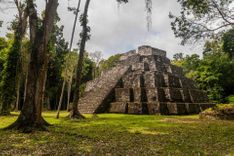The region east of Guatemala City is the most disparate part of the country — a mix of near-desert, rainforest, mountains, and lakes peopled by ladinos, creoles, and isolated pockets of Maya. Close to the capital is a seldom-visited area of dry, sun-scorched hills known as the Oriente, centred on the towns of Chiquimula and Esquipulas. The eastern section of Guatemala, the department of Izabal, could not be more different. Here the climate is always thick with humidity and the land has a decidedly sultry, tropical feel, with rainforest reserves, a Caribbean coastline, a vast lake, and a dramatic gorge system to explore. If you’re planning a trip to Guatemala, this region is ideal if you want variety and fewer tourists.
The depth of tradition evident here is startling. Men fill the streets with colour in their red-and-white-striped trousers, black woollen breeches, brilliantly embroidered shirt collars and natty straw hats; women wear dark blue cortes and superbly intricate purple huipiles. Todos Santos is one of the few places where people still use the 260-day Tzolkin calendar which dates back to ancient times. Highland traditions and the epic surroundings have long captivated visitors, and photographers in particular, though you should be wary of taking pictures of people – particularly children. In this isolated community rumours persist that some foreigners steal babies.
Todos Santos is a great place to simply hang out but it would be a shame not to try a traditional sauna (chuc) while you’re here – most guesthouses will prepare one for you. Note that Todos Santos has declared itself a dry town, so no alcohol is sold (except during the fiesta); Casa Familiar guests are exempt.
Learning Spanish or Mam in Todos Santos
Hispano Maya (hispanomaya.weebly.com), opposite the Hotelito Todos Santos, offers four to five hours’ instruction a day – plus accommodation and meals with a local family for around US$150 a week. Excursions and activities are run too. As Spanish is the second language here (after Mam), it’s as much about the cultural experience as the studying.




